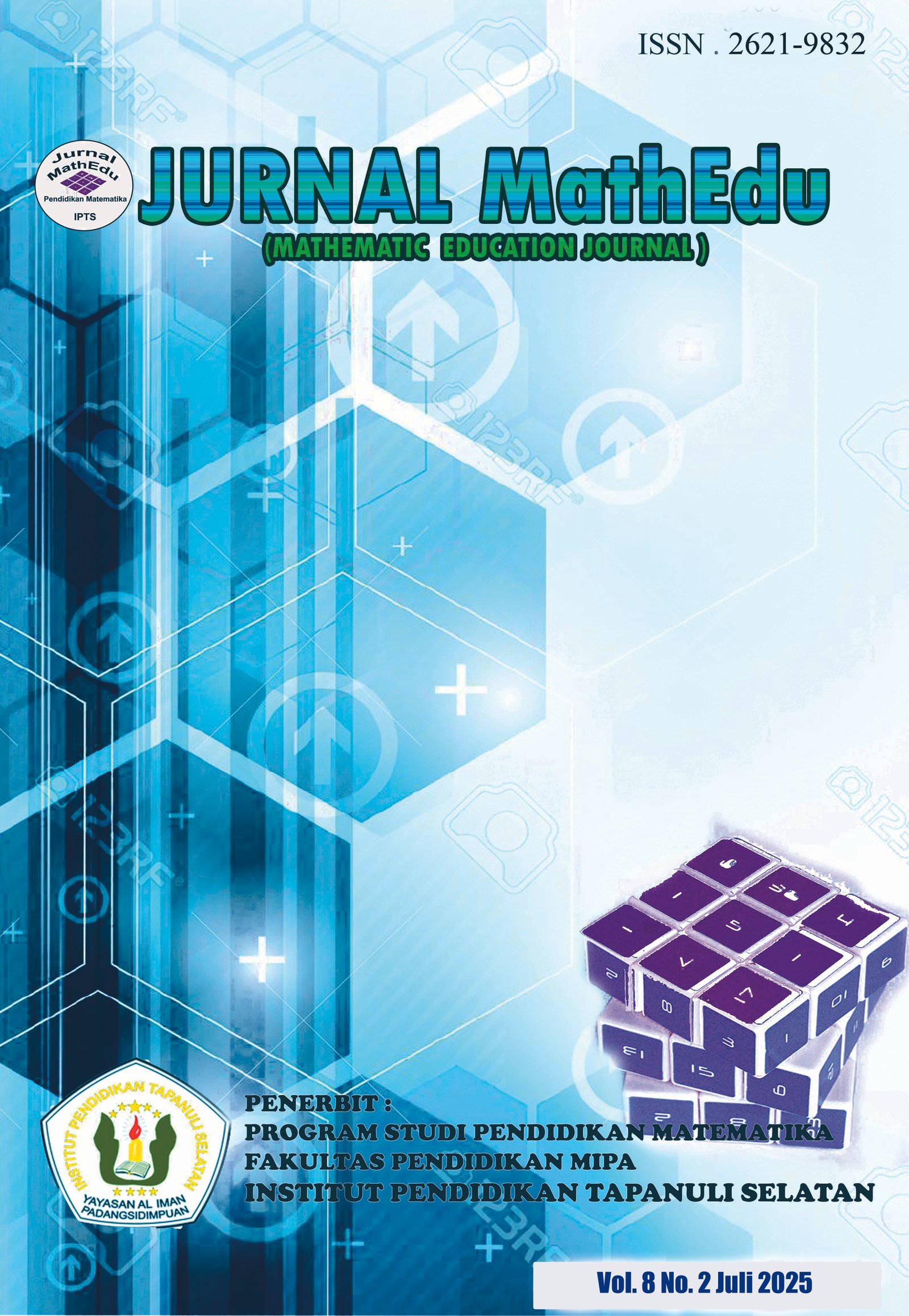Pengembangan E-Modul Berbantuan Flipbook Maker untuk Membangun Kemampuan Pemahaman Konsep Siswa di SMK Negeri 4 Padangsidimpuan
Main Article Content
Abstract
Abstract
This study aimed to know the Validity, Effectiveness and Practicality of the development of E-Modules assisted by Flipbook Makers in building students’ mathematical concept understanding abilities at SMK Negeri 4 Padangsidimpuan by using the R&D method. The research used the ADDIE design which has 5 stages, namely Analysis, Design, Development, Implementation, and Evaluation. The subjects involved in this study were 17 students at the tenth grade students of DKV 1 at SMK Negeri 4 Padangsidimpuan. The results of this study indicated the validity of the development of E-Modules assisted by flipbook makers from the three expert lecturers as validators who assessed the aspects of media, materials, and language. The conclusion obtained from this research and development was the validation result from the three validators of 90.5 (very valid category) while the effectiveness of using the module was obtained from the results of the test analysis of students’ mathematical concept understanding abilities with a classical completeness percentage of 94% and the practicality of the product was obtained from the positive response of students as evidenced by filling out the questionnaire with a percentage of 95% (very valid category). It means that the development of e-modules assisted by flipbook makers was concluded to be valid, effective and practical in building students’ mathematical cconceptual understanding abilities at SMK Negeri 4 Padangsidimpuan.
Article Details
Authors who publish with this journal retain copyright to their articles. However, they grant the journal the right of first publication with the work simultaneously licensed under a Creative Commons Attribution License that allows others to share the work with an acknowledgment of the work's authorship and initial publication in this journal.
References
Barlian U., Dkk. 2022. Penggunaan Media Flipbook Interaktif Berbasis Kvisoft Flipbook Maker Dalam Meningkatkan Penguasaan Konsep Pola Bilangan Pada Pembelajaran Matematika: Dwija Cendekia Jurnal Ristek Pedagogik. Vol. 6. Hal. 779-790.
Damayanti., Y. & Anita., I. 2023. Karakteristik Kemampuan Pemahaman Konsep Siswa Kelas Vii Di Mts Az-Zahra Porongpong Berdasarkan Gender: Jurnal Pembelajaran Matematika Inovatif. Vol. 6, Hal. 1831-1840.
Effendy., E. 2023. Pemahaman Konsep Peserta Didik Kelas Vii Pada Maateri Segi Empat: Jurnal Fakultas Keguruan Dan Ilmu Pendidikan. No.2 Vol. 8. Hal. 16-22.
Finola. 2016. Pengembangan Bahan Ajar Matematika Dasar Layanan Jurusan Non Eksak: Fibbonaci Jurnal Pendidikan Matematika Dan Matematika. Vol. 2 No. 1.
Kholiza, S. 2023. Efektivitas Model Pembelajaran Inquiry Terhadap Kemampuan Berpikir Kreatif Siswa Pada Materi Teorema Pythagoras: Jurnal Cendikia : Jurnal Pendidikan Matematika. Vol. 3, No 2 Hal 121-132.
Mawaddah. (2016). Analisis Kemampuan Pemahaman Konsep Matematis Dalam Menyelesaikan Soal Materi SPLDV Pada Siswa SMP. Prossiding Seminar Nasional Dan Matematika Pendidian Matematika Sesiomadika 2019, 1(1) 546-554.
Musyrifah., E. Dkk. 2022. Pengembangan Bahan Ajar Matematika Bagi Guru Mi Dalam Upaya Mendukung Keterampilan Mengajar Serta Peningkatan Literasi Numerasi: Fibonacci (Jurnal Pendidikan Matematika Dan Matematika). Vol. 8 Hal. 61-72.
Nuraeni., 2020. Analisis Pemahaman Karakter Pada Pendidikan Anak Usia Dini: Jurnal Upi. Vol. 12. Hal. 9-16.
Sugianto. (2013). Peningkatan Kemampuan Pemahaman Konsep Matematika Siswa SMP Melalui Penemuan Terbimbing Berbantu Sofware Geogebra. MES (Jurnal Of Mathematics Education And Science), 2(1), 1-9.
Supriadi., S. 2015. Pemanfaatan Sumber Belajar Dalam Proses Pembelajaran Matematika Di Kelas X Sma N 2 Jambi: Jurnal Ar-Raniry. Vol. 1. No.2.hal. 777-785.
Yulianty., N. 2018. Kemampuan Pemahaman Konsep Matematika Siswa Dengan Pendekatan Pembelajaran Matematika Relistik: Jurnal Pendidikan Matematika Reflesia. Vol. 04. Hal. 60-65.
Wardhani., 2008. Analisis Kemampuan Pemahaman Konsep Siswa Pada Ateri Peluang: Jurnal Unsika. Vol. 2.

